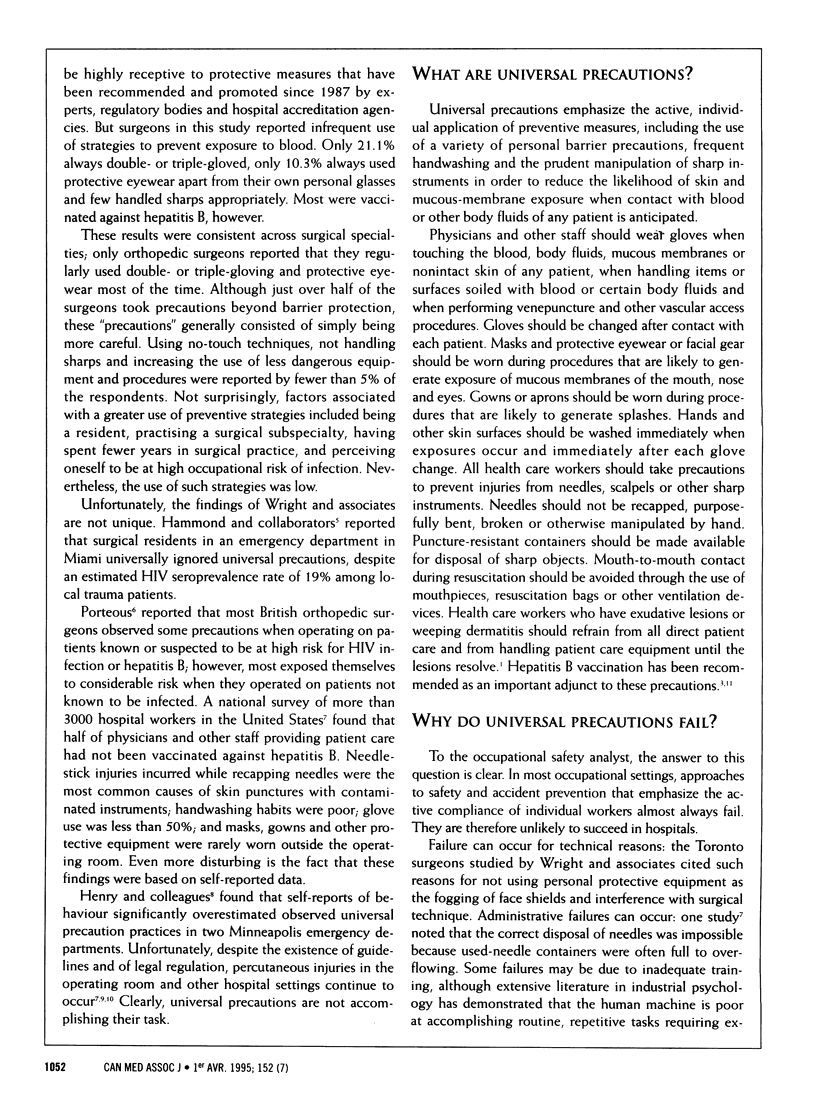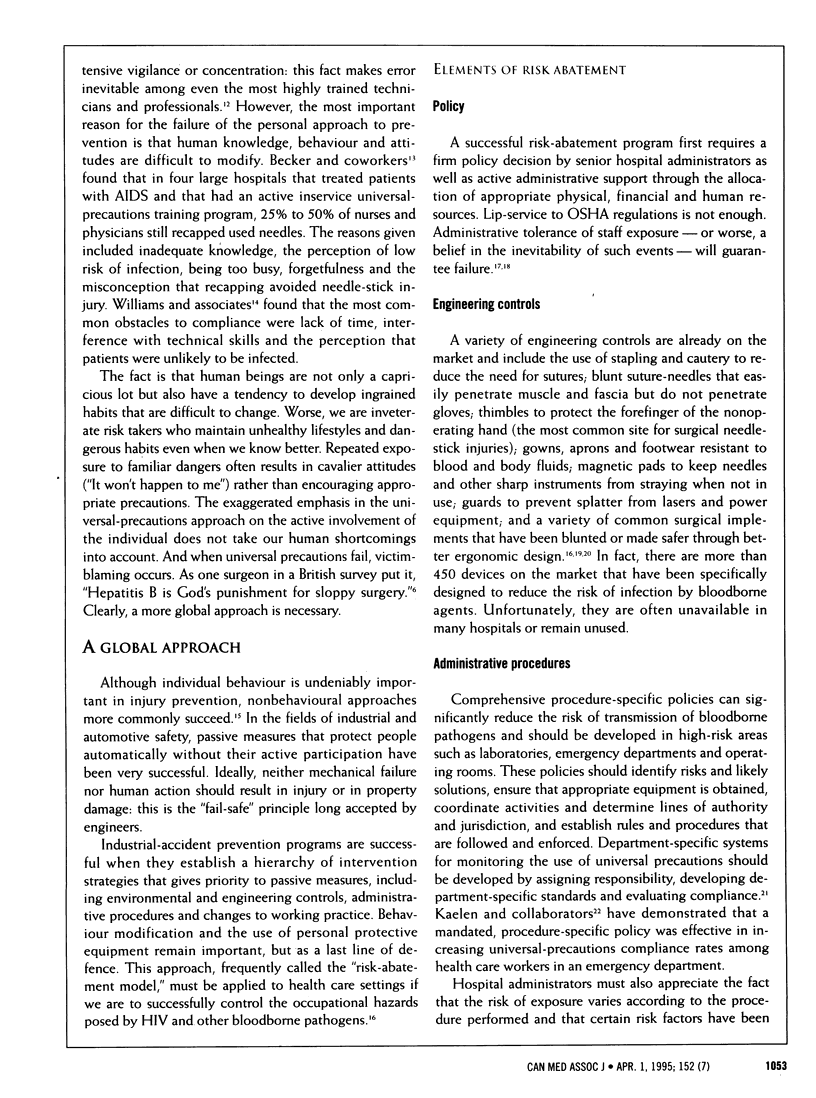Abstract
Universal precautions have gained wide acceptance in the literature and are promoted by major health care regulatory bodies as a measure to prevent nosocomial transmission of bloodborne diseases. Nevertheless, Dr. James G. Wright and associates (see pages 1089 to 1095 of this issue) provide evidence of the infrequent use of universal precautions by surgeons in Toronto. Their findings are consistent with those of similar studies and point to the limitations of any safety approach that relies on the active compliance of individuals rather than on passive, environmental controls. Successful approaches to optimizing workplace safety should first emphasize passive measures for risk abatement, including firm policies, the use of safer equipment and techniques, procedural safeguards and regular monitoring. Routine voluntary screening of patients undergoing procedures that pose a high risk of contamination may improve compliance to safety procedures by health care personnel. Further study is required.
Full text
PDF




Selected References
These references are in PubMed. This may not be the complete list of references from this article.
- Becker M. H., Janz N. K., Band J., Bartley J., Snyder M. B., Gaynes R. P. Noncompliance with Universal Precautions Policy: why do physicians and nurses recap needles? Am J Infect Control. 1990 Aug;18(4):232–239. doi: 10.1016/0196-6553(90)90164-n. [DOI] [PubMed] [Google Scholar]
- Bennett B., Duff P. The effect of double gloving on frequency of glove perforations. Obstet Gynecol. 1991 Dec;78(6):1019–1022. [PubMed] [Google Scholar]
- Bessinger C. D., Jr Preventing transmission of human immunodeficiency virus during operations. Surg Gynecol Obstet. 1988 Oct;167(4):287–289. [PubMed] [Google Scholar]
- Davis J. M., Demling R. H., Lewis F. R., Hoover E., Waymack J. P. The Surgical Infection Society's policy on human immunodeficiency virus and hepatitis B and C infection. The Ad Hoc Committee on Acquired Immunodeficiency Syndrome and Hepatitis. Arch Surg. 1992 Feb;127(2):218–221. doi: 10.1001/archsurg.1992.01420020108015. [DOI] [PubMed] [Google Scholar]
- DeFilippo V. C., Bowen R. W., Ingbar D. H. A universal precautions monitoring system adaptable to any health care department. Am J Infect Control. 1992 Jun;20(3):159–163. doi: 10.1016/s0196-6553(05)80184-1. [DOI] [PubMed] [Google Scholar]
- Garner J. S., Simmons B. P. Guideline for isolation precautions in hospitals. Infect Control. 1983 Jul-Aug;4(4 Suppl):245–325. [PubMed] [Google Scholar]
- Gerberding J. L., Littell C., Tarkington A., Brown A., Schecter W. P. Risk of exposure of surgical personnel to patients' blood during surgery at San Francisco General Hospital. N Engl J Med. 1990 Jun 21;322(25):1788–1793. doi: 10.1056/NEJM199006213222506. [DOI] [PubMed] [Google Scholar]
- Gerberding J. L. Procedure-specific infection control for preventing intraoperative blood exposures. Am J Infect Control. 1993 Dec;21(6):364–367. doi: 10.1016/0196-6553(93)90403-q. [DOI] [PubMed] [Google Scholar]
- Hammond J. S., Eckes J. M., Gomez G. A., Cunningham D. N. HIV, trauma, and infection control: universal precautions are universally ignored. J Trauma. 1990 May;30(5):555–561. [PubMed] [Google Scholar]
- Henry K., Campbell S., Collier P., Williams C. O. Compliance with universal precautions and needle handling and disposal practices among emergency department staff at two community hospitals. Am J Infect Control. 1994 Jun;22(3):129–137. doi: 10.1016/0196-6553(94)90001-9. [DOI] [PubMed] [Google Scholar]
- Hersey J. C., Martin L. S. Use of infection control guidelines by workers in healthcare facilities to prevent occupational transmission of HBV and HIV: results from a national survey. Infect Control Hosp Epidemiol. 1994 Apr;15(4 Pt 1):243–252. [PubMed] [Google Scholar]
- Jagger J., Hunt E. H., Pearson R. D. Sharp object injuries in the hospital: causes and strategies for prevention. Am J Infect Control. 1990 Aug;18(4):227–231. doi: 10.1016/0196-6553(90)90163-m. [DOI] [PubMed] [Google Scholar]
- Kaczmarek R. G., Moore R. M., Jr, McCrohan J., Arrowsmith-Lowe J. T., Caquelin C., Reynolds C., Israel E. Glove use by health care workers: results of a tristate investigation. Am J Infect Control. 1991 Oct;19(5):228–232. doi: 10.1016/s0196-6553(05)80253-6. [DOI] [PubMed] [Google Scholar]
- Kelen G. D., Green G. B., Hexter D. A., Fortenberry D. C., Taylor E., Fleetwood D. H., Sivertson K. T. Substantial improvement in compliance with universal precautions in an emergency department following institution of policy. Arch Intern Med. 1991 Oct;151(10):2051–2056. [PubMed] [Google Scholar]
- Montz F. J., Fowler J. M., Farias-Eisner R., Nash T. J. Blunt needles in fascial closure. Surg Gynecol Obstet. 1991 Aug;173(2):147–148. [PubMed] [Google Scholar]
- Panlilio A. L., Foy D. R., Edwards J. R., Bell D. M., Welch B. A., Parrish C. M., Culver D. H., Lowry P. W., Jarvis W. R., Perlino C. A. Blood contacts during surgical procedures. JAMA. 1991 Mar 27;265(12):1533–1537. [PubMed] [Google Scholar]
- Popejoy S. L., Fry D. E. Blood contact and exposure in the operating room. Surg Gynecol Obstet. 1991 Jun;172(6):480–483. [PubMed] [Google Scholar]
- Porteous M. J. Operating practices of and precautions taken by orthopaedic surgeons to avoid infection with HIV and hepatitis B virus during surgery. BMJ. 1990 Jul 21;301(6744):167–169. doi: 10.1136/bmj.301.6744.167. [DOI] [PMC free article] [PubMed] [Google Scholar]
- Pugliese G. Should blood exposures in the operating room be considered part of the job? Am J Infect Control. 1993 Dec;21(6):337–342. doi: 10.1016/0196-6553(93)90399-o. [DOI] [PubMed] [Google Scholar]
- Quebbeman E. J., Telford G. L., Hubbard S., Wadsworth K., Hardman B., Goodman H., Gottlieb M. S. In-use evaluation of surgical gowns. Surg Gynecol Obstet. 1992 May;174(5):369–375. [PubMed] [Google Scholar]
- Quebbeman E. J., Telford G. L., Hubbard S., Wadsworth K., Hardman B., Goodman H., Gottlieb M. S. Risk of blood contamination and injury to operating room personnel. Ann Surg. 1991 Nov;214(5):614–620. doi: 10.1097/00000658-199111000-00012. [DOI] [PMC free article] [PubMed] [Google Scholar]
- Quebbeman E. J., Telford G. L., Wadsworth K., Hubbard S., Goodman H., Gottlieb M. S. Double gloving. Protecting surgeons from blood contamination in the operating room. Arch Surg. 1992 Feb;127(2):213–217. doi: 10.1001/archsurg.1992.01420020103014. [DOI] [PubMed] [Google Scholar]
- Tokars J. I., Bell D. M., Culver D. H., Marcus R., Mendelson M. H., Sloan E. P., Farber B. F., Fligner D., Chamberland M. E., McKibben P. S. Percutaneous injuries during surgical procedures. JAMA. 1992 Jun 3;267(21):2899–2904. [PubMed] [Google Scholar]
- Treloar C. J., Malcolm J. A., Sutherland D. C., Berenger S., Higginbotham N. Hospital administrators' tolerance of staff needlestick injuries. Infect Control Hosp Epidemiol. 1994 May;15(5):307–310. doi: 10.1086/646917. [DOI] [PubMed] [Google Scholar]
- White M. C., Lynch P. Blood contact and exposures among operating room personnel: a multicenter study. Am J Infect Control. 1993 Oct;21(5):243–248. doi: 10.1016/0196-6553(93)90416-2. [DOI] [PubMed] [Google Scholar]
- Williams C. O., Campbell S., Henry K., Collier P. Variables influencing worker compliance with universal precautions in the emergency department. Am J Infect Control. 1994 Jun;22(3):138–148. doi: 10.1016/0196-6553(94)90002-7. [DOI] [PubMed] [Google Scholar]


